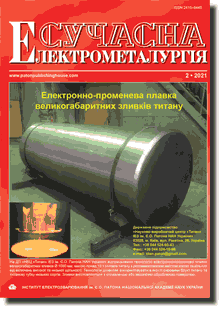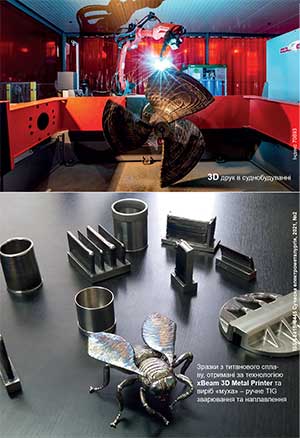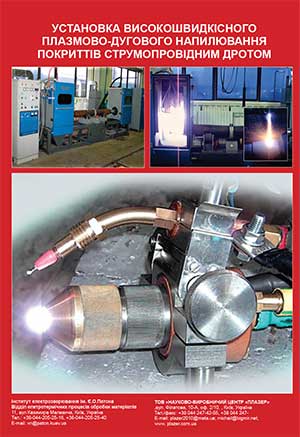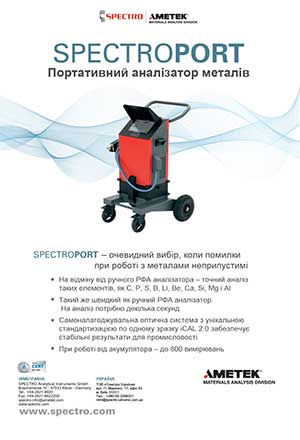| 2021 №02 (01) |
DOI of Article 10.37434/sem2021.02.02 |
2021 №02 (03) |

Electrometallurgy Today (Sovremennaya Elektrometallurgiya), 2021, #2, 13-18 pages
Production of large-sized titanium ingots by the method of electron beam melting
S.V. Akhonin1, O.M. Pikulin1, V.O. Berezos1, A.Yu. Severin1, O.G. Erokhin2
11E.O. Paton Electric Welding Institute of the NAS of Ukraine. 11 Kazymyr Malevych Str., 03150, Kyiv, Ukraine. E-mail: office@paton.kiev.ua 2SC «SPC «Titan» of the E.O. Paton Electric Welding Institute of the NAS of Ukraine»
26 Raketna Str., 03028, Kyiv, Ukraine. E-mail: titan.paton@gmail.com
Abstract
Comprehensive research was performed on producing large-sized ingots of 1100 mm dia and up to 3 m length from Grade 2 titanium alloy by the method of cold-hearth electron beam melting in the production facilities of SC «SPC «Titan» of the E.O.Paton Electric Welding Institute of the NAS of Ukraine» in a multifunctional electron beam unit UE5810. It is shown that in production of large-sized titanium ingots by cold-hearth electron beam melting the energy losses for radiation and evaporation should be compensated by the efficiency of the melting process, taking into account the general metal losses for evaporation. As a result of the studies, it was determined that the content of impurity elements in the metal of the produced ingot meets the requirements of the standard, hydrogen concentration being not higher than 0.002 % that is 7 times smaller than the maximum value allowed by the standard, and no increased content of oxygen or nitrogen was found either in the ingot bottom or head parts. It is shown that the metal of the largesized titanium ingot produced by cold-hearth electron beam melting has no internal defects in the form of nonmetallic inclusions, pores or discontinuities, and no significant difference is observed between the macrostructure of the ingot central and peripheral zones, which is characteristic for ingots in vacuum arc remelting. Ref. 15, Tabl. 1, Fig. 6.
Keywords: cold-hearth electron beam melting; electron beam installation; large-sized titanium ingot; titanium; impurity element; ultrasonic testing; nonmetallic inclusions; macrostructure
Received 20.05.2021
References
1. Kablov, E.N. (2012) Strategic directions in development of materials and technologies of their processing up to 2020. Aviats. Materialy i Tekhnologii, S, 7–17 [in Russian].2. Ryabtsev, A.D., Troyansky, A.A., Fridrikh, B. et al. (2014) Alloying of titanium with carbon in the process of chamber electroslag remelting, Sovrem. Elektrometall., 2, 3–9 [in Russian].
3. Iliin, A.A., Kolachev, B.A., Polkin, I.S. (2009) Titanium alloys. Composition, structure, properties. Moscow, VILS-MATI [in Russian].
4. Leokha, F.L., Ratiev, S.N. (2012) Modern methods for producing titanium alloys doped with oxygen. Naukovi Pratsi DNTU. Ser. Metalurgiya, 1–2, 85–94 [in Russian].
5. Paton, B.E., Trigub, N.P., Akhonin, S.V. (2008) Electron beam melting of refractory and high-reactive metals. Kiev, Naukova Dumka [in Russian].
6. Paton, B.E., Trigub, N.P., Akhonin, S.V. (2003) Promising technologies of electron beam melting of titanium. Titan, 2, 20–25 [in Russian].
7. Kelkar, K., Mitchell, A. (2020) Beta Fleck formation in Titanium Alloys the 14th World Conference on Titanium (Ti 2019) MATEC Web of Conferences, 321, 1001. doi.org/10.1051/ matecconf/202032110001.
8. Mitchell, A., Kawakami, A. (2007) Segregation and solidification in titanium alloys. Ti-2007 Science and Technology. The Japan Institute of Metals. https://cdn.ymaws.com/titanium. site-ym.com/resource/resmgr/ZZ-WCTP2007-VOL1/2007_ Vol_1_Pres_35.pdf
9. Hongchao Kou, Yingjuan Zhang, Pengfei Li et al. (2014) Numerical simulation of titanium alloy ingot solidification structure during VAR process based on three-dimensional CAFE method. Rare Metal Materials and Engineering, 43(7), 1537-1542. https://doi.org/10.1016/S1875-5372(14)60120-X
10. Gao, L., Huang, H., Jiang, Y. et al. (2020) Numerical study on the solid-liquid interface evolution of large-scale titanium alloy ingots during high energy consumption electron beam cold hearth melting. JOM, 72, 1953-1960. https://doi.org/10.1007/s11837-020-04089-5
11. Zhang Yong, Kou Hongchao, Li, P. et al. (2012). Simulation on solidification structure and shrinkage porosity (hole) in TC4 ingot during vacuum arc remelting process. Tezhong Zhuzao Ji Youse Hejin/Special Casting and Nonferrous Alloys, 32, 418–421.
12. Paton, B.E., Trigub, N.P., Berezos, V.A. et al. (2010) Production of large ingots of titanium-based creep-resisting alloys by electron beam melting. Advances in Electrometall., 3, 168–171.
13. Zhuk, G.V., Trigub, N.P., Fesan, A.A. (2008) Energy characteristics of EBCHM process of titanium alloys. Ibid., 4, 13–15.
14. Sobolevskaya, T.D., Gishkina, V.I., Kovalenko, T.A. (2009) Influence of quality of sponge titanium on presence of defects in semi-finished products and parts from titanium alloys. Novi Materialy i Tekhnologii v Metalurgii ta Mashynobudivnytstvi, 2, 50–54 [in Russian].
15. Illarionov, A.G., Popov, A.A. (2014) Technological and service properties of titanium alloys: Tutorial. Ekaterinburg, Izdvo Ural. Un-ta [in Russian].




